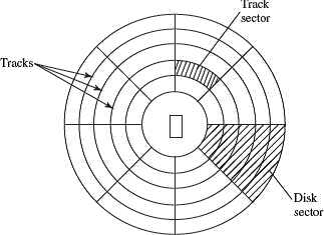Magnetic Disk
Magnetic Disk
Magnetic disk is a direct access secondary storage device. It is a thin plastic or metallic circular plate coated with magnetic oxide and encased in a protective cover. Data is stored on magnetic disks as magnetized spots. The presence of a magnetic spot represents the bit 1 and its absence represents the bit 0.
The working of magnetic disk
» The surface of disk is divided into concentric circles known as tracks. The outermost track is numbered 0 and the innermost track is the last track. Tracks are further divided into sectors. A sector is a pie slice that cuts across all tracks. The data on disk is stored in sector. Sector is the smallest unit that can be read or written on a disk. A disk has eight or more sectors per track
» Magnetic disk is inserted into a magnetic disk drive for access. The drive consists of a read/write head that is attached to a disk arm, which moves the head. The disk arm can move inward and outward on the disk.
» During reading or writing to disk, the motor of disk drive moves the disk at high speed (60–150 times/sec.)

Accessing data on the disk requires the following —
Seek Time
The read/write head is positioned to the desired track where the data is to be read from or written to. The time taken to move the read/write head to the desired track is called the seek time.
Latency Time
Once the read/write head is at the right track, then the head waits for right sector to come under it (disk is moving at high speed). The time taken for desired sector of the track to come under read/write head is called the latency time.
Data Transfer Rate
Once the read/write head is positioned at the right track and sector, the data has to be written to disk or read from disk. The rate at which data is written to disk or read from disk is called data transfer rate.
Access Time
The sum of seek time, latency time and time for data transfer is the access time of the disk.
» The storage capacity of disk drive is measured in gigabytes (GB).
» Large disk storage is created by stacking together multiple disks. A set of same tracks on all disks forms a cylinder. Each disk has its own read/write head which work in coordination.
» A disk can also have tracks and sectors on both sides. Such a disk is called double-sided disk.
The features of magnetic disk are —
• Cheap storage device
• Can store a large amount of data
• Easy to carry or transport
• Suitable for frequently read/write data
• Fast access device
• More reliable storage device
• To be prevented from dust, as the read/write head flies over the disk. Any dust particle in between can corrupt the disk.
